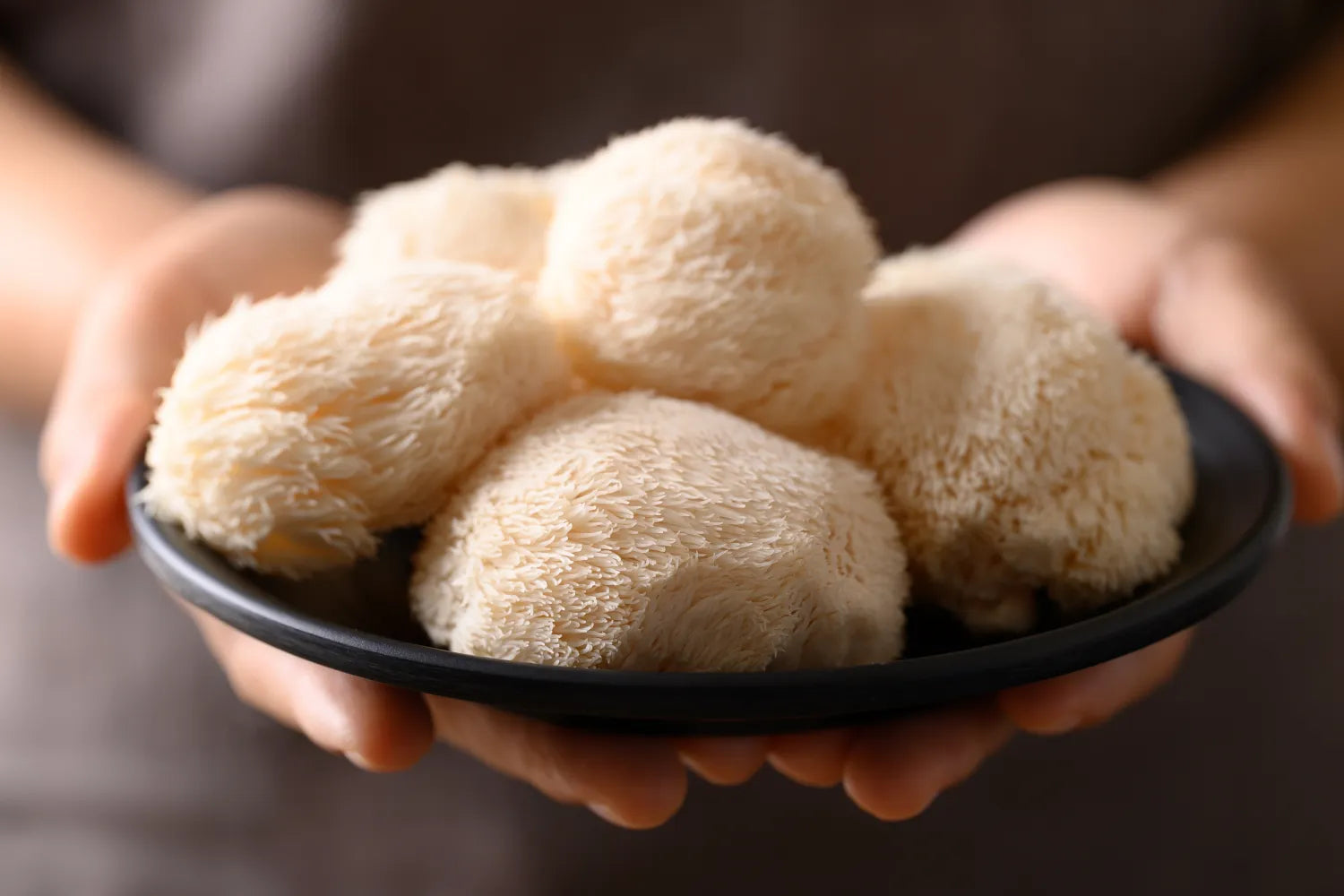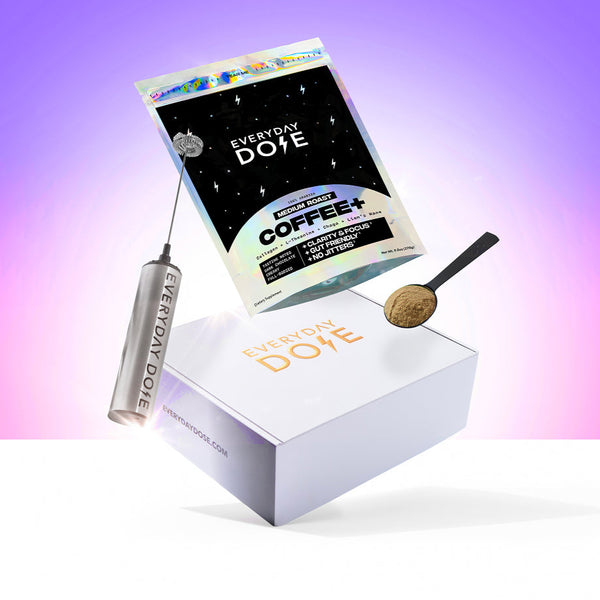The Origin and History of the Lion's Mane Mushroom

When you take a supplement every day, it can be easy not to put much thought into it. But have you ever really thought about where your supplement comes from? We’re not just talking about the quality of the supplement (although that’s important, too). We’re also talking about the substance as a whole.
For instance, lion’s mane mushroom is a supplement that’s been getting more and more popular, but it’s far from a new discovery. Lion’s mane has been a staple in traditional medicine for centuries. Read on to learn more about the history of lion’s mane, where it comes from, and how modern research has confirmed its traditional uses.
What Is Lion’s Mane Mushroom?
Meet Hericium erinaceus. This fungus flaunts a cascade of white, icicle-like spines, earning it nicknames like lion's mane, bearded tooth, and hedgehog mushroom. It looks like a massive puffball, and you won’t find any traditional mushroom parts like stalks, caps, or gills.
This mushroom belongs to the Hericiaceae family and is a proud member of the Basidiomycota phylum. Originally dubbed Hydnum erinaceus, it later claimed its rightful place in the Hericium genus. The name "erinaceus" is Latin for "hedgehog," a nod to its spiny appearance.
But lion's mane isn't just a Western wonder. In China, it's known as Hóutóugū (猴头菇), meaning "monkey head mushroom." In Japan, it's called Yamabushitake (山伏茸) in reference to the Yamabushi monks, who wore shaggy garments that echoed the mushroom's appearance.
Where Does Lion’s Mane Come From?
Lion's mane mushrooms are surprisingly well-traveled, native to North America, Europe, and Asia. They have a particular fondness for hardwood trees, especially beech and oak, where they grow on dead or dying trunks. These mushrooms are also saprotrophic, meaning they feed on decaying wood, but they can also act as mild parasites on living trees with wounds.
In Europe, lion's mane has become a rare sight, which is why it’s on the red list in several countries due to poor germination and establishment. Conversely, they’re more common in parts of Asia and North America, especially in temperate forests.
Their fruiting season typically spans late summer to early autumn, but this can vary depending on the local climate. So, if you're wandering through the woods during these months, keep an eye out for these shaggy ‘shrooms.
How Has Lion’s Mane Been Used Historically?
Long before lion's mane became a trendy supplement, it was revered in traditional medicine. In Traditional Chinese Medicine (TCM), lion's mane was used to support digestive health, boost vitality, and as a general tonic to enhance life energy, or "qi.”
Japanese monks, particularly those practicing Shugendō, consumed lion's mane to enhance focus during meditation, believing it helped in achieving spiritual enlightenment.
Beyond Asia, ancient Greeks were no strangers to the medicinal properties of fungi. While specific records on lion's mane are scarce, it's believed that they utilized various mushrooms, which potentially included lion's mane, for their soothing and skin-supporting properties.
Culinarily, lion's mane has been a delicacy for centuries. Its seafood-like flavor and meaty texture make it a popular ingredient in gourmet dishes, where it’s often used as a substitute for crab or lobster.
How Is Lion’s Mane Grown Today?
Fast forward to today, and lion's mane has transitioned from forest floors to controlled cultivation. Modern growers have mastered the art of cultivating this mushroom using substrates like hardwood sawdust, which is often supplemented with wheat bran to boost yields.
China dominates the global production of lion's mane, with regions like Zhejiang and Fujian leading in production. However, interest in cultivating lion's mane is growing worldwide, with North America and Europe seeing a surge in local farms and DIY cultivation kits.
The mushroom is now available in various forms. You can find it fresh, dried, powdered, in capsules, and even infused into coffees and teas. For instance, it’s one of the star ingredients in our Mushroom Coffee+, alongside collagen, chaga mushroom, coffee extract, and L-theanine.
What’s the Research on Lion’s Mane?
Lion's mane mushroom is a subject of growing scientific interest due to its potential health benefits. Research has explored its effects on cognitive function, nerve regeneration, mood enhancement, and more.
Cognitive Function
A randomized, double-blind, placebo-controlled study investigated the effects of Hericium erinaceus on cognitive function in individuals with mild cognitive impairment. Participants who consumed lion's mane supplements for 16 weeks showed significant improvements in cognitive function compared to the placebo group.
However, these benefits started to fade after participants stopped taking the supplement, suggesting that you may need to keep taking it to see long-term effects.
Further research has identified compounds in lion's mane, such as hericenones and erinacines, that may support the body’s production of nerve growth factor (NGF), which is key for the growth and maintenance of neurons.
Mood Stabilization
A study examining the acute and chronic effects of lion's mane supplementation found that it might improve cognitive performance and reduce feelings of stress in healthy young adults. While the results are promising, more studies with larger sample sizes are needed to confirm these findings.
Gut Health
Lion’s mane mushroom has become quite popular for its potential to support gut health, primarily through its influence on the gut microbiota and intestinal barrier function.
A study involving healthy adults found that short-term consumption of H. erinaceus powder positively influenced the gut microbiome, especially when it came to beneficial bacteria such as Bifidobacterium and Lactobacillus species. These effects were also associated with healthy blood lipid profiles, suggesting that lion’s mane may also support heart health.
Further research has demonstrated that polysaccharides in lion’s mane can support the intestinal lining. In vitro and in vivo studies showed that these polysaccharides could support the expression of tight junction proteins and mucins, which are important for maintaining the gut barrier. This can help keep harmful substances out of the bloodstream, which can support overall health.
Sleep Support
Beyond cognitive and gut health, lion’s mane mushroom has been studied for its potential to support high-quality Zzzs.
In a clinical study involving overweight or obese individuals with mood and sleep disorders, an eight-week supplementation of lion’s mane showed a positive correlation with sleep quality, as well as lower feelings of depression and anxiety. These effects also supported the balance of brain-derived neurotrophic factor (BDNF) and its precursor, pro-BDNF.
Animal studies have also given us plenty to think about. One study introduced stress-induced sleep disturbances to mice. Giving these mice lion’s mane mycelium decreased behaviors associated with anxiety and supported non-rapid eye movement (NREM) sleep patterns.
Research also suggests that H. erinaceus extracts can influence circadian rhythms. In mice, H. erinaceus extract supported the sleep-wake cycle and helped the mice feel more tired at the end of the day.
The Bottom Line
Lion's mane mushroom might look funny, but it packs some amazing health benefits. This mushroom has been used in traditional medicine for hundreds of years, and modern science is now confirming many of those traditional uses.
The good news is, you don’t have to travel halfway across the world or spend the day in the woods to find high-quality lion’s mane. Nowadays, you can find this functional fungus in any of our mushroom blends. Explore our selection today and find one that fits your needs!
Sources:
Neurological Activity of Lion's Mane (Hericium erinaceus) | Journal of Restorative Medicine
Hericium erinaceus extracts alter behavioral rhythm in mice | PubMed
Start your day
The Right Way








